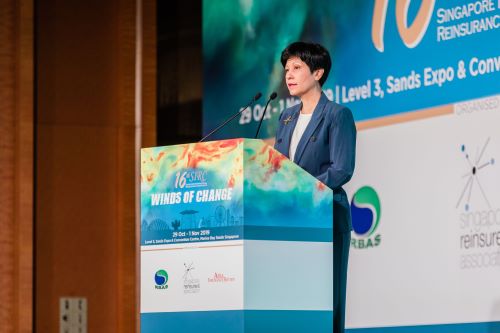

Indranee Rajah, Minister in the Prime Minister’s Office and Second Minister for Finance and Education of Singapore, delivers the keynote speech at the Singapore International Reinsurance Conference
The insurance industry and the global economy are facing strong headwinds from a continuously changing and challenging environment, according to Indranee Rajah, Minister in the Prime Minister’s Office and Second Minister for Finance and Education of Singapore.
Rajah delivered the keynote speech at the Singapore International Reinsurance Conference (SIRC) on October 30, and she spoke about how the global economy is undergoing a tumultuous period of change.
“Climate risks and political risks have evolved significantly, and emerged at the forefront of major threats that have potential to derail the growth of the global economy,” she said.
In line with the conference’s theme of ‘Winds of Change’, Rajah discussed two winds of change faced by the global economy – environmental headwinds and political headwinds. Decisive and concerted action, she said, is needed to mitigate these risks.
Environmental headwinds
According to Rajah, climate change is affecting the global frequency, severity, and distribution of natural catastrophes and extreme weather events, such as windstorms, floods, and heatwaves. Asia has been one of the hardest hit regions, with natural catastrophe events increasing from an annual average of 44 in the 1970s to 144 in 2018, while the related economic losses for the region in the same period have risen from an annual average of US$5 billion to US$89 billion.
“Singapore is working closely with ASEAN and the insurance industry to mitigate the impact of climate risk on our region’s economic and social development through its work with the ASEAN Disaster Risk Financing and Insurance Programme (ADRFI) and Southeast Asia Disaster Risk Insurance Facility (SEADRIF),” she said.
Rajah also put forward the use of alternative risk transfer solutions, such as insurance-linked securities, or ILS, to guard against natural catastrophe risks.
Political headwinds
“The way forward for Asia’s continued growth is the expansion of cross-border trade in order to create greater investment and economic opportunities,” Rajah said. “This will require the region to develop the necessary infrastructure required to connect our economies together.”
Asia’s infrastructure requirements stand at over US$1.7 trillion a year until 2030, but investors remain cautious investing in long-term projects, particularly in new pastures where the risks are starker due to unfamiliarity, she said.
Under the Belt & Road Initiative (BRI) Insurance Consortium, there has been an addition of two new lines of business to the Consortium, namely, political violence and political risk. China Re and Chaucer have come together with Singapore-based Lloyd’s syndicates and insurers to establish a political violence facility with an initial capacity of US$250 million to insure against risks of political violence in countries along the BRI.
Furthermore, 10 Singapore-based political risk insurers have come together to establish a political risk insurance facility with a total insurance capacity of US$700 million. Together with the other two existing lines of business coordinated by China Re, namely, construction all risk and project cargo, these facilities will put the Singapore insurance market at the forefront of providing a one-stop solution for infrastructure projects, including the BRI.
“The industry must work with other key actors, including policymakers, regulators, technology firms and academia, to overcome some of the systemic challenges in addressing these risks,” Rajah said in her conclusion. “These challenges include a dearth of data in the region, a lack of uniform or inter-operable standards and definitions, and an insufficient base of research and development combining technical, actuarial, economic and social analysis and approaches. Partnerships will be critical in addressing the significant protection gaps facing the region, to support sustained growth and economic development, and enhance Asia’s resilience.”
